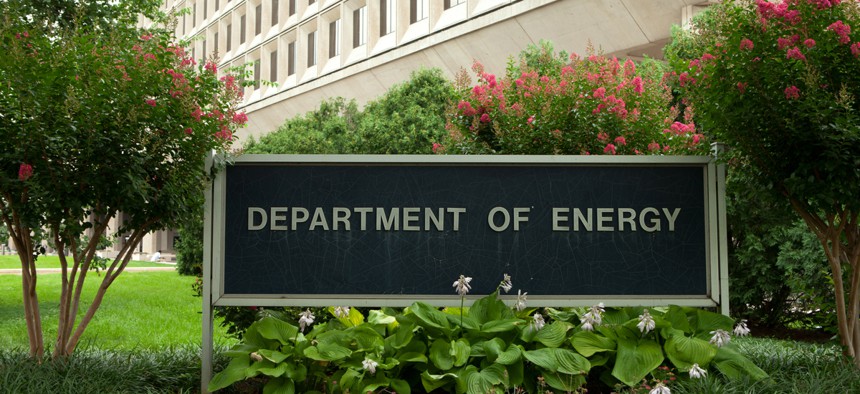Why Five New National Quantum Information Science Centers Are a Huge Deal

Mark Van Scyoc/Shutterstock.com
Through quantum computers, we’ll tackle some of the world’s greatest challenges, explain Energy Department's Paul Dabbar and IBM Research's Darío Gil.
Throughout its history, the United States has thrived—and prospered—by opening new frontiers.
In national projects like the Apollo Program, the Digital Revolution, or the Human Genome Project, the federal government working with the private sector, has opened new frontiers of science and technology, accelerated research and sped the arrival of new and unexpected benefits to Americans.
Today, America is leading the quantum frontier though a new national project involving the Department of Energy, its national labs, the expertise of scientists at universities, and the energy and ingenuity of the private sector.
DOE has established five new quantum information science centers at its national labs with funding of over $965 million, including $625 million in authorized funding from the DOE over five years, and over $340 million from the center participants.
Why is this announcement different? These five centers bring together U.S. national labs, academia and industry, in a bid to accelerate progress in fundamental quantum information science research.
Progress in quantum research should lead to much more advanced technologies like cutting-edge quantum sensors, technologies needed for the development of the nation’s quantum internet, and the holy grail of quantum information science, a fully functional quantum computer. Or, in science terms, a fault-tolerant quantum computer that can compute without errors.
Through quantum computers, we’ll tackle some of the world’s greatest challenges. The process of scientific discovery, be it for a new vaccine or new materials for better energy storage batteries, involves an iterative process of experimentation. Computers can accelerate the process of discovery through simulations, but as impressive as our computers are today, there are many problems that they cannot solve due to simply too many variables to compute.
Enter quantum computing. By building machines designed with and for quantum mechanics, we can elegantly use the quantum power of nature to solve these very problems.
Quantum computers should follow the fundamental design of quantum circuits. Our current computers execute logical circuits to run software programs behind the scenes. Quantum machines will use the physical phenomena of superposition, entanglement, and interference to implement mathematical calculations out of the reach of even our most advanced current and future supercomputers.
To realize the full promise of quantum computing, we will need to build machines that can compute without errors. Quantum information is both powerful and delicate, built from qubits (short for quantum bits). Any external disturbances or "noise," such as heat or vibrations, yank these qubits out of their quantum state and make them into just regular bits.
Overcoming this hurdle requires teamwork. While a large institution could design a quantum computer with hundreds, perhaps thousands of qubits, a fault-tolerant quantum computer requires a national effort of scientists from the national labs, industry and academia. These new centers will unite the best minds from across the U.S. R&D sectors to work together on specific quantum-related issues.
DOE also announced the Quantum Internet Blueprint in July, to build the nation’s quantum internet. It includes four priority research areas: building foundations for the quantum internet; integrating quantum networking devices; creating repeating, switching, and routing technologies for quantum entanglement; and enabling error correction of quantum networking functions.
The Blueprint also recommends five key milestones for that construction, from sending and receiving quantum information over limited-range fiber networks—an effort that is developing today—to integrating both classical and quantum networking technologies in the continental-scale communications system of tomorrow. In addition to a quantum internet, we have a unique opportunity to develop quantum intranets that will allow for the connection of quantum processors over short distances, just like we connect today’s computer chips inside data centers through intranets. This form of distributed quantum computing will be key to build large scale quantum computers.
Through the partnerships and collaboration at the new centers, we’ll have the opportunity to make the quantum leaps our nation needs, at an accelerated speed. With a long-term vision of establishing a robust national quantum ecosystem, academia, national labs and industry partners now have a view of the quantum roadmap—where we need to get to, and how to get there, together. The centers should become testbeds for quantum technology across America.
As they develop and flourish, so will we, developing new applications and technologies, and opening new horizons in engineering and design, science and innovation, from foundational new science to the creation of new materials to the development of personalized medicines.
The opportunities that these new centers offer will have a rippling effect, boosting demand for quantum information science expertise at companies and institutions across America—and the world.
Let’s dive in and leap into our quantum future—together.
Paul Dabbar is the Under Secretary of Energy for Science at the Department of Energy.
Darío Gil is the director of IBM Research.
NEXT STORY: Amazing Mars Mission Nearing Red Planet



